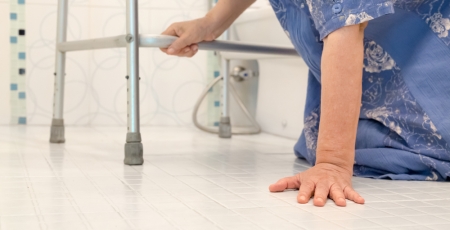Top 10 tips to prevent a slip, trip or a fall in 2020
Anyone can have a fall, but older people are more vulnerable and likely to fall, especially if they have a long-term health condition. Falls are the number one reason older people are taken into A&E (Age UK, 2019) and a result of a fall, people may lose their confidence, independence or perhaps go into long term care. Consequently, falls cost the NHS over £2bn and over 4million bed days per year*.
There are many ways in which a slip, trip or a fall at home. We have put together our top 10 tips to ensure your client remains safe within their own home, preventing them from entering A&E, and ensuring beds are available:
1. Remove hazards from your home.
The easiest method for preventing a trip of a fall is to keep your floors free clutter such as piles of newspapers, electrical/ phone cords etc.
Move coffee tables, plant stands or any other furniture from high-traffic areas
Secure loose rugs with double-faced tape, tacks or a slip resistant backing - or remove loose rugs from your home completely
Store food, dishes, clothing, toiletries etc. within easy reach
Use nonslip mats in your shower or bathtub, or use a bath seat to allow you to sit whilst showering
Fix loose carpet or repair loose floorboards
Ensure any spillages are cleaned or mopped up immediately
2. Use assistive devices
Install handrails or grab bars. These safety devices are crucial for going up and downstairs, getting on and off the toilet, stepping in and out of the bathtub, or outside near to front or back doors.
A raised toilet seat or one with arms
A sturdy, non-slip stool or chair for the shower
3. Avoid wearing loose clothing.
You want to feel comfortable at home, but baggy clothing can sometimes make you more likely to fall. Opt for better fitting and properly hemmed clothing that doesn’t bunch up or drag on the ground
4. Light up your living space
Inadequate lighting is another major hazard. To create a home that’s more suitable for the elderly, install brighter light bulbs where needed, particularly near to staircases, hallways and outdoor lighting.
Another option is to add night lights in bedrooms and bathrooms for better visibility during the night.
Have a torch stored in a convenient place in case of a power cut
5. Keep moving!
Physical activity can go a long way toward fall prevention. With your Doctor’s OK, consider activities such as walking, water workouts or tai chi. For something a little less strenuous, try simple leg and arm raises.
If you avoid physical activity because you’re afraid it will make a fall more likely, tell your Doctor. They may recommend a carefully monitored exercise programme or refer you to a physiotherapist.
6. Make sure you can see clearly
Always wear glasses if you need them, but remember to remove reading glasses before you walk
Ensure you have your eyes checked regularly 7.Be aware of the possible side effects of your medication
7. Be aware of the possible side effects of your medication
Side effects of some medication can increase the risk of falls. Taking several different medicines each day can increase the risk and may cause weakness or dizzy spells
Always read the information about side effects that come with each of your medicines
Talk to your pharmacist or doctor about possible side effects
Ask for a review of your medicines if you’re unsure
8. Seek help when you need it
The right care and support when you need it can help you to live more safely and maintain the individual’s independence. Don’t leave it too late to ask for help and advice. You can find out more about preventing falls from the NHS website - https://www.nhs.uk/conditions/falls/
If your client feels stronger and more capable in the morning, but tired and weaker in the evening, it may be worthwhile organising home care assistants to visit the client during evening hours to prepare them for bed. For clients who feel unable to stand during evenings, a transfer aid such as Handicare's ReTurn7500i will enable a sit-to-stand or a stand-to-sit.
9. Get help lighting items that are bulky, heavy or difficult to lift
10. Stairs
An extra bannister rail or a stairlift can make getting up and down the stairs easier. If your client feels stronger The transition from sitting to standing often incurs the risk of a fall and yet whilst this task carries risk, a fall is not inevitable. Following an assessment, Handicare can provide support and equipment which work for both the client and the carer.
*Statistic from Public Health England 2019.

